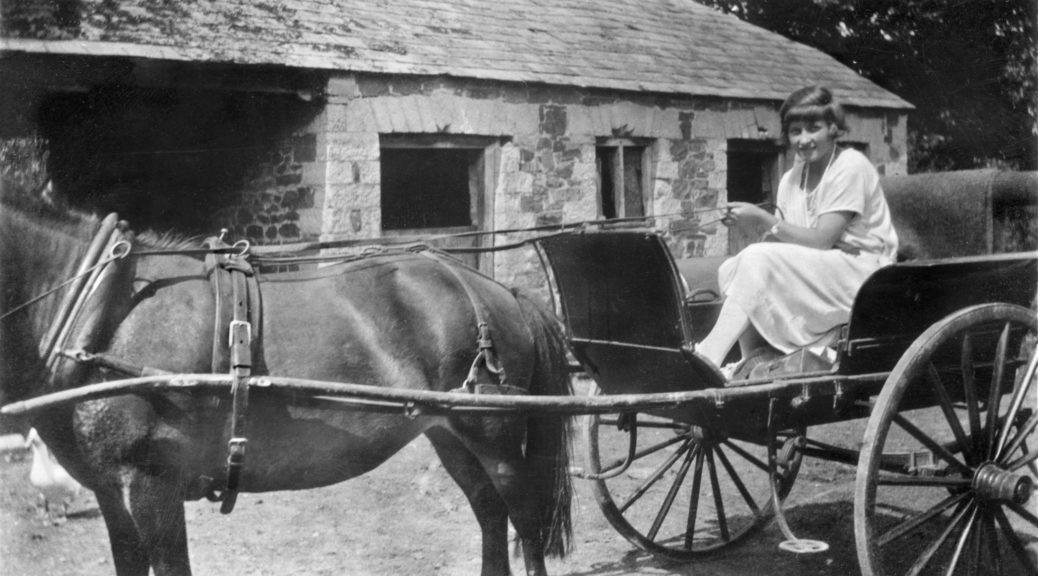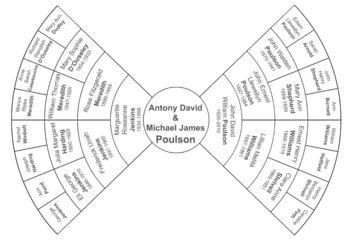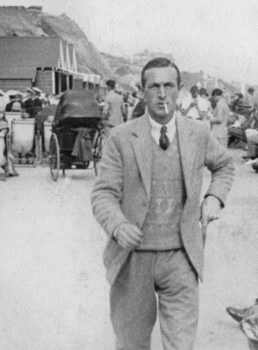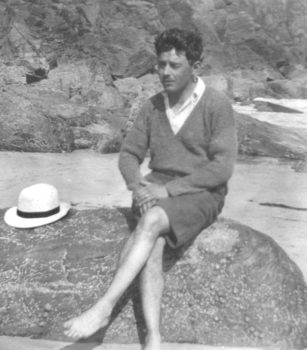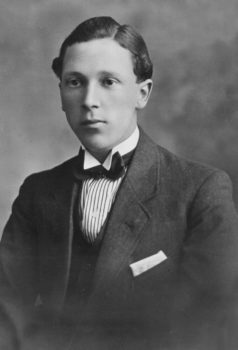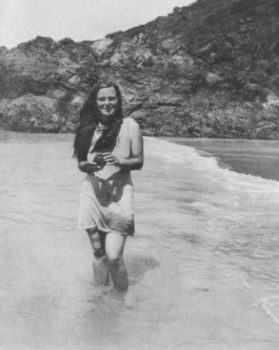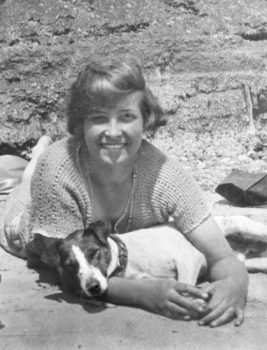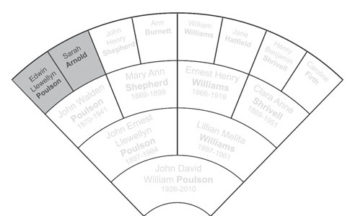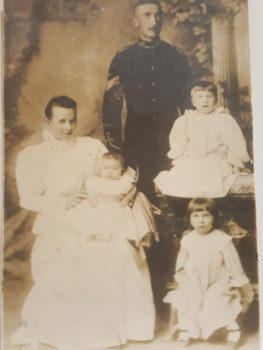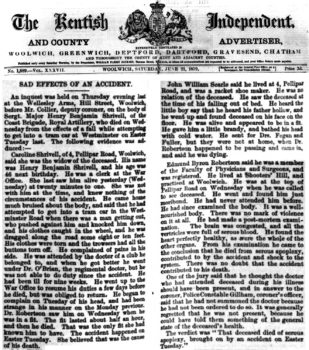I’ve spent many hours combing through records and newspaper articles about ancestors and long-dead relatives, and although there’s much I don’t know, I realized I have lots of thumbnail sketches of where they lived, what sort of work they did and occasionally other snippets of information which I haven’t shared. The more substantial stories – such as interfering in an election in Pontefract – have blog posts, but the smaller details are only in my head. Recently I sent my brothers two bow-tie charts, and one replied that it looked odd as he’d never heard of many of the names. Time to put a little flesh on those bones!
Finding a way to present incomplete family stories is a challenge – I have always postponed, hoping to fill in more of the details, or find equal amounts about each branch of the family. This is an attempt to put together what I have, holes and all – I can always edit later if more becomes available. The starting point is the five Poulson children – me and four younger brothers. We need two bow-tie charts as we have two Mums. I’m including all stories as the five of us were raised together even though our ages and different grandparents mean we didn’t all know the same people or places equally.
There’s a tangent we only knew about as adults – that our Dad had a daughter, Yvette, born around 1944-5 in Marignane, France. His story was that Marie-Antoinette’s family wouldn’t allow them to marry as they were Catholic (and he wasn’t). I wonder if my DNA test might eventually make a connection, but otherwise, we know nothing about Yvette’s story after this photo, so no third bow-tie chart.
The charts span five generations – us in the center and our 2nd great-grandparents at the edge. We were born between 1954 and 1969, our parents from 1926-1934, our grandparents from 1895 -1899, our great-grandparents from 1866-1870 (Poulson), 1846-1854 (Jenkins) and 1858-1871 (Forster). 2nd great-grandparents are a much wider range, born from 1804-1848. Almost everyone was born in the UK, except William Williams in Germany and Lilian Williams in Malta. The shortest life was Sarah Arnold – 2nd great-grandmother – who died at 24. The longest life was Rose Meredith who died 5 days shy of her 100th birthday. Our three parents were all involved with the theatre, but occupations diverge widely for earlier generations – soldiers, farmers, manufacturers, a brewer, a customs agent. No one very rich, but no one in dire poverty. Some huge families (11 children) some small (a couple of only children).
Assuming we all know as much as we care to about the world we were born into, I’m looking outward on the bow-tie to earlier generations. I have separated our parents’ childhoods – them as our grandparents’ children – into a second blog post as this is already long. Let’s start with our grandparents.
The 1920s – our grandparents marry. The Great War ended in 1918 and over the next year or two, men who had fought returned home. David Poulson’s father John returned from India in 1920. Yvonne Forster’s father Len returned from France in 1919. Margo Jenkins’ father Derek served in the Royal Engineers in France and Germany, returning to attend Bartlett School of Architecture at University College London.
Len Forster & Wynne Procktor married in Stamford Hill Congregational Church in 1922, John Poulson & Billie Williams in St. Luke’s, Portsea (Portsmouth) in 1923 and Derek Jenkins & Rose Meredith at the Church of St. Barnabas in Kensington in 1927. The only wedding photo I have is of Derek & Rose, looking very smart and very 1920s at their wedding on December 17, 1927.
Our parents were born late 20s/early 30s, and without World War I interrupting, marriage & family would probably have started sooner for our grandparents. Given “surplus women” in the UK, perhaps they considered themselves lucky to be marrying – two of John Poulson’s sisters remained single (although Goggie did marry a widower late in life). Our parents were in smaller families than the generations before – Yvonne Forster was an only child, David and Margo one of two.
We have many occupations among the grandparents and their parents, and three different areas of the country they came from. Rose Meredith studied at the Royal College of Music, gained her ACRM and taught piano lessons, but as far as I know did not hold paid full time employment. The other two grandmothers did not do paid work at all. Our parents moved away from where they grew up – no one living in the town they were born in or joining a family business.
John Poulson went to work for Barclays Bank after WWI, starting as a clerk and moving up to manager at various branches in Southern England – Portsmouth, Chichester, Winton, Wimborne and Salisbury. He was born in Knottingley, Yorkshire and his father managed (for a while) his father Edwin’s pottery business in Ferrybridge (town nearby). John’s mother died just before his second birthday (9 days after giving birth to a sister who didn’t live); his aunt/stepmother also died young (TB); and he was estranged from his father (who had abandoned his second wife and 6 kids when John was 12, which precipitated a move to Portsmouth for John and one older sister Goggie. They lived with their Aunt Mary (John Walden’s sister), her solicitor husband Theophilus, and their cousin Edwin Wood. One of John’s uncles ran the pottery after Edwin Poulson’s death in 1925, but the earthenware business was already in decline, so there was probably no reason to return to Knottingley. Possibly John’s train wreck of a father had burned too many bridges. Grandfather Edwin helped his grandson with a contact at Barclays Bank after leaving the army and a bequest in his will of £500 (about £30K today) – as the only boy, he received twice what his sisters did.
Derek Jenkins was an architect, working initially in London and then for the County in Taunton, Somerset. Derek grew up on a farm in Keynsham, Somerset, the youngest of 11 children. His father Eli at first had a large-ish farm (300 acres in the 1881 census) and then was listed as a commercial agent for rennet and cattle cakes (I had to look that up – pellets of cow kibble, essentially) in the 1901 census. It’s not clear what drew Derek to architecture – his next older brother Ernest worked for the National Telephone Company (according to his attestation forms for WWI); Henry Winboult Jenkins sold bird seed as a commercial traveller (but left the equivalent of £3.7 million when he died in 1938, so did well financially). Albert Eli was a mechanical engineer, Edgar John was also a bird seed manufacturer (and he left his widow the equivalent of £5.35 million when he died in 1927 – who knew there was so much money in bird seed?). Or in being a corn merchant – older brother John Hedley Jenkins left the equivalent of £1.28 million when he died in 1938. Only the oldest, George Percy, started out as a dairyman, but he left for Australia in 1899 and became an Ice Merchant – so no one carried on the farming tradition.
Len Forster worked for insurance companies as an underwriter, primarily British & Foreign Marine Insurance. He grew up in Hackney and then Stoke Newington, London. Len was not close with his family – his father Edwin was a surgical instrument maker and apparently hard to get along with. Len was the third of four boys (a fifth brother had died at age 2 before Len was born) with big age gaps, so they had little in common. His mother started helping in the business, so he was left with the housemaid much of the time until he went to school. His education was interrupted by long stays in the hospital after a burst appendix in 1910, so he acquired a number of skills on the job – shorthand & typing, then French during the war (he was rated as unfit for military service, so volunteered for the ambulance service and was billeted with a French family in Le Havre). After the war he taught himself Spanish to work in Barcelona with a shipping company (again staying with a Spanish family who spoke no English to help him learn). The contacts there led to the job at the British & Foreign and returning to England. I know nothing about his work for the insurance company, but I don’t think he found it engaging. Playing violin in the Lloyd’s company orchestra (he had also taught himself to play the violin when young) which was very active in playing for events in London was what he really enjoyed. He and Wynne lived in and around London until he retired to Worthing, Sussex. The family stories were that Len’s father was from Germany and that his mother, born Marie Therésè Cundalé was French (or her family was). I have traced both families back to the late 1700s and everyone was born in England. Brothers Horace & Hubert followed their father into surgical instrument making; Fred was a warehouse clerk when young.
The grandmothers didn’t have paid occupations, but here they are when young women.

Great-grandparents: Where were they from? Yorkshire (Poulson & Shepherd); Brighton, Germany, London, Malta, Bermuda, Kent (Williams & Shrivell); London (Forster & Cundale); Canada, London & Devon (Procktor & Ford); Somerset & Dorset (Jenkins & Harding); Ireland, Gloucestershire, London & Somerset (Meredith & D’Ouseley).
John Ernest Llewellyn Poulson, the fourth child of John Walden Poulson and Mary Ann Shepherd, was born in 1897 in Knottingley, Yorkshire. He had three older sisters, Poul (Emily Muriel), who became an English teacher at the Chelmsford High School for girls and remained single, Gwen (Nellie Gwendolyn) who qualified as a midwife, then married and moved to Australia, and Goggie (Doris Marguerite) who became a nurse in Portsmouth. After Mary Ann died in 1899, John Walden married her younger sister Emily Shepherd in 1901 – the older four had their aunt as their stepmother, which seems both comforting and slightly weird. John Walden and Emily had two more daughters before he deserted the family in 1910. Emily tied of tuberculosis in 1917 when her daughters were 15 and 12.
Emily’s father John Henry Shepherd, with his second wife (his first, Mary Ann and Emily’s mother Ann Burnett died in 1889), gave his granddaughters Millicent Mary and Ethel Suzanne a home when their father left in 1910, I assume as Emily was already ill. Millicent became a nurse, moved to the Federated Malay States, met and married Eric Mumford ( in 1931), the assistant police commissioner. She returned to England for visits, and in 1938 permanently, presumably as the signs of war indicated it wasn’t safe to remain. Suzanne worked for a department store in Leeds as a hat buyer and then opened her own store, Florence & Clare.
John Walden Poulson was a litany of wasted chances, betrayals and a very sad end (search the blog if you haven’t read his many sorry tales), but as the first born son of Edwin Llewellyn Poulson and Sarah Arnold, he appeared to have every advantage starting out. Knottingley is a small town on the River Aire about 20 miles south east of Leeds in Yorkshire. Edwin and his brother Thomas had inherited the Poulson Brothers Pottery from their father, Walden Poulson, and built it up to be a major local employer. Edwin’s wife, Sarah, was the youngest (of 11) daughter of a master mariner – in the “Coasting Trade” – so she wouldn’t have seen much of her father growing up. There was lots of shipping in Knottingley – materials in and goods out through Goole and then Hull or Grimsby. Sarah Arnold was only 24 when she died, leaving two very young children – Mary Ellen and John Walden. Edwin married again (another Emily – Austwick) and had two more sons, ran the pottery, was a Justice of the Peace and was on the board of guardians for the Pontefract workhouse – the quintessential pillar of the community.
Mary Ann Shepherd was the second child – and oldest daughter – of eight. Her mother Ann died in April 1889, her father remarried in June, and by August, Mary Ann was pregnant. I don’t know how she and John Walden met, but there was a July Knottingley Horticultural show where newspaper accounts mentioned both families attending (as participants & judges), which I think is a possibility.
Once Mary Ann’s condition was obvious, her father (I assume) insisted on a marriage – which took place in the Ferry Fryston Church at Christmas with John Walden lying about his age (he was only 19) presumably because he couldn’t get his father’s permission. In May, their daughter was born. This was a crazy few years for the Shepherds. With their mother dead and Mary Ann moving to Knottingley after her marriage, two of her younger sisters, Emma and Emily, had to look after their siblings and two boarders. John Henry was managing the Red Lion Inn with his new wife while Emma & Emily kept house for the rest of his family.
Perhaps this was less strange at the time than it sounds today – many families lost mothers when they were young whereas now, that’s the exception. At some point after Mary Ann’s death in 1899, her younger sister Emily must have come to help with the four children, ages 9, 8, 3 and 2. It wasn’t until 1901 that Emily and John Walden were married, and that required some subterfuge and a trip to Newcastle-on-Tyne!
Billie Williams was born into a military family, on the move as Ernest Henry Williams was reassigned in the Royal Field Artillery. She was born at Fort Ricasoli, Malta, and her two younger brothers in Bermuda. Her two older sisters were born in Felixstowe, Essex and Portsmouth. Clara Anne Shrivell was also a child of a Royal Artillery family. Her stepfather worked at the Woolwich Barracks at the same time as the young Corporal Williams. Their street addresses from the census were close to the barracks and to each other, so I assume that’s how Clara and Ernest met.
Some time around 1907 Ernest Henry retired from the RFA and ran a tobacconist shop on 274 Commercial Street in Portsmouth. Both Ernest & Clara’s boys became career soldiers, Dick (Walter Richard) in the RAF and Joe (Ernest Henry Jr) in the RFA. Joe’s service included a stint in a Japanese prisoner of war camp following the fall of Singapore in 1942, something he was lucky to have survived, but which left him much changed, according to Dad.
Maisie, the oldest sister, was married in Portsmouth in 1914 when Sis (Edith Maud) was 20 and Billie was 17, both still living at home. Their father died in March 1919, so did not see Sis married in September 1919 or Billie in April 1923. There were lots of pictures of the three sisters – many of the later ones with John & Goggie Poulson, plus Ernie Ellis – so I think they regularly socialized and probably all attended each other’s weddings.
Ernest Henry’s father William Williams was born in Elberfeld, Germany – his father Richard Williams was a civil engineer and English teacher who presumably moved for work. William’s mother, Eleonore Eschrich, was German. William returned to England some time before 1861 when he was a lodger in Burton-upon-Trent working as a brewer, possibly having learned that craft in Germany? In 1864, in St. James Westminster, William Williams, Brewer, marries Jane Hatfield, daughter of James Hewitt Hatfield, a Dental Surgeon – based on census records for Jane’s father and the other entries in the parish register, I’m guessing that William was marrying up.
They had 3 boys and a girl – Ernest Henry was the second born and the only one to go into the armed services. His oldest brother William left for the US and settled in Chicago as a postal clerk. His younger brother Walter Richard was a bank manager. His baby sister, Amy, married a book editor. The three boys were together in the 1880s at a boarding school (small, judging by the census) in Luton. Without knowing if they enjoyed the school, it seems better that three of the four of them were together there.
Henry Benjamin Shrivell was the 6th of seven children born in Brighton to a bricklayer, William Frederick George Shrivell, and his wife Sarah Hughes, sixth of eight daughters of John Hughes, a fisherman in Brighton. Brighton was swarming with Shrivells in the late 1700s and early 1800s. Large families and most of them stayed put. Henry’s grandfather Cornelius Shrivell (born and died in Brighton) was one of at least 11 Cornelius Shrivells I’ve tracked down. Lots of James, Robert & Thomas Shrivells too.
Henry Benjamin broke away by joining the Royal Artillery, marrying a woman, Caroline Firth, from Charlton, Kent and dying in Woolwich. None of Henry & Caroline’s children were born or lived in Brighton. The youngest of their four children, Clara Anne, came the closest – she died (I think in a nursing home) in Worthing, just a few miles down the coast from Brighton.
Henry’s father died when he was 14, and by 16 he was a solicitor’s clerk, living with his widowed mother Sarah. Sarah was working as a “seampstress” along with one of her daughters; her older son was a tailor’s apprentice and only the 9 year old was still at school. Everyone was trying to make ends meet, but perhaps a solicitor’s office wasn’t interesting, and a career in the Royal Artillery would provide a ticket out. He joined some time in the 1850s; by 1861 was a Sergeant at the Woolwich Royal Artillery Barracks; in 1863 he married Caroline Firth (one of twelve children of an agricultural laborer) and worked at the Woolwich barracks until his gruesome death in 1879 in a tram accident – he was only 44. He was working in administrative positions from 1870 to 1875 (based on a London directory entry for him: “War Office, Office of, Deputy Adjt.Gen. of Artillery”). The newspaper article about the inquest into his death, left, said he was a Sergeant Major in the Coast Brigade and had been ill for about 9 weeks following being dragged under some tram wheels. Then he had a seizure and died – verdict “serous apoplexy, brought on by an accident”. Irrelevant but juicy detail; John William Searle, who testified at the inquest, became the widow Caroline’s next husband.
Clara Anne was only 10 when her father died. Her mother remarried 3 years later and had one more daughter. Their house at 36 Hill Street was very close to the RA Barracks – where her stepfather worked – which is how I assume she ran into Corporal Ernest Henry Williams. She and Ernest were married in January 1892 and off to the Territorial Army Garrison in Felixstowe, Essex. Their first child, Maisie, was born about 6 months later, so this was likely another marriage of necessity. Her mother Caroline would have no reason to lecture as her daughter by her second husband arrived about three months after the wedding.
Forster & Cundale. Edwin William Forster was born in Tottenham, London, the seventh of eight children of a man with a variety of artistic careers and at least one bankruptcy, Frederick Valentine Forster. His mother, Emily Hellen Watson, was the oldest of four children of a lamp and chandelier maker. Edwin and his younger sister Emily were shipped off to board with an elderly couple in Ramsgate, possibly relating to chaos following his father’s bankruptcy in 1863 (Edwin was born in 1864). Seems very hard to be in that situation at 7 and 5 years old (1871 census). By 1881 he was back with his parents in London, working as a surgical instrument maker and in 1886 he married Marie Therese Cundale, fifth of eight children of a plasterer turned bookkeeper, William Cundale, and his wife Elizabeth Payne (youngest daughter of a shoe maker). Marie Therese was born in Tottenham and both her parents were born and raised in London – small moves, such as Hackney to Stoke Newington, but essentially London born and bred.
Marie Therese was variously Mary Theresa, Marie, Mary Therese – hard to say why so many variations except perhaps that no one was too concerned about spelling variations at the time. There was no French heritage as far back as I could check (late 1700s). I have no idea how Edwin & Marie Therese met – they weren’t in the same neighborhood. By the standards of the time, Marie Therese was old when they married – she was 27 and Edwin 23. Lots of unanswered questions.
Procktor & Ford. William Alfred Procktor was the oldest child of William Thomas Procktor, a cabinet maker and Elizabeth Brown, middle daughter of a carpenter. All born in London, but William Alfred spent some time in Canada as a child before his father returned to London around 1875. William Alfred did clerical work for a hardware company and married relatively late, at 30, to Mary Jane Ford, the only daughter of William John Ford and Jane Kelland. Janie Ford was born in Plymouth, Devon. Her parents moved to London when one of Jane Kelland’s two illegitimate sons moved to start business there as a builder. William Ford worked for Jane’s son for a while, even though he had been a cordwainer – shoe maker – in Devon. In the 1881 census, William & Jane Ford and Mary Jane are living with the builder William HT Kelland and his wife. Even though he had not been in London long and was only 24, he was already employing 21 men, according to the census.
By 1891, Mary Jane is working as a builder’s clerk (presumably for the family business) and her cordwainer father is now a carpenter. In 1896 she and William Alfred are married and although I don’t know how they met, their families were living only a mile apart in London, so perhaps William Alfred’s company had business with Mary Jane’s brother’s building company?
Jenkins & Harding. Eli George Jenkins was a farmer born in Dorset to a farmer – his father George Jenkins, who was a “Dairyman – cow keeper” in the 1851 census, moved up to a 120-acre and then 190-acre farm. Ann Pond, who married George as a widow with two children in 1846, also grew up on a farm in Dorset. Her father had died when she was only 4, and her mother married again (to a farmer); when that farmer died, Ann’s mother Mary kept the farm going until her death. Farming was what everyone in that area did.
Julia Margaret Harding had also grown up on a farm. Her father, Joseph Harding and his wife, Rachel Winbolt, were responsible for a method of producing cheddar cheese that was widely known. As Julia was in Marksbury and Eli was in Motcombe Dorset, once again I don’t know how these two connected. Odds are good it had something to do with farms, milk or cheese!. Eli and Julia married in 1872 in the parish church in Marksbury, and then raised their children on a farm in Marksbury. In the 1881 census, Julia’s mother Rachel (newly widowed) is with them and the census record for her occupation is “interest of money”!
Meredith & D’Ouseley. I have written blog posts about the exploits of William Thomas Meredith, the paintings of Mary Sophie D’Ouseley, and her father, Richard Standish D’Ouseley, who led a full, if somewhat complicated life. The blogs contain as much information as I have about the two families.

